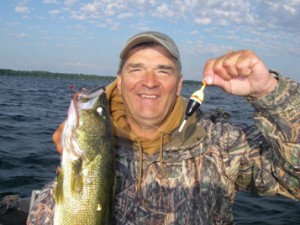Quick Thinking Slip Bobber Rigging!
by Greg Bohn with Scott Richardson
Fumbling around trying to keep bait in the water costs time and missed fish when the walleye bite is on.
Action can happen fast and furious and ends just as quickly. Being prepared and making adjustments to your slipbobber rigs in a hurry can mean the difference between two fish or twenty. Advances in tackle design, packaging and storage help you stay in the thick of things.
 Start right. A split shot, a slipbobber, a bobber stop and a hook aren’t enough. Today’s slipbobbers are as versatile as any other method to catch ‘eyes – maybe more so. They can be used with minnows, ‘crawlers and leeches. They can sport different colored hooks or jigs like the Bohn-designed Bobber Bug.
Start right. A split shot, a slipbobber, a bobber stop and a hook aren’t enough. Today’s slipbobbers are as versatile as any other method to catch ‘eyes – maybe more so. They can be used with minnows, ‘crawlers and leeches. They can sport different colored hooks or jigs like the Bohn-designed Bobber Bug.
A Bohn brainstorm led to the addition of a small blade to the Lindy Pro Series snells. The flash caused when a squirming leech or minnow tries to escape is sometimes all it takes for the walleye to pull the trigger. The rigs produce 50 percent more strikes than the common slipbobber, split shot and hook.
In our book, Mastering the Art of Slipbobbers: The Deadliest Method for Walleyes, we described the modern slipbobber rig. A bobber stop made of thread is followed by a red glass bead that adds enough color to be seen from a distance and slides smoothly to prevent hang-ups. Next, the slipbobber must be designed to slide easily on the line. That’s followed by a Lindy No-Snagg barrel swivel which features one eye larger than the other. The bigger one goes toward the slipbobber to prevent the swivel from becoming stuck inside.
A Water Gremlin rubbercore sinker – not a split shot – is attached halfway down the 2-foot snell. A split shot damages the line. The rubbercore sinker balances the bobber without weakening the line at all and allows weight changes quickly.
The business end is a Tru-Turn hook in bleeding red or gold or a Bobber Bug in perch or firetiger, the most consistent walleye-catching colors. Bobber Bugs range from 1/32 , 1/16 and 1/8 ounces. The Pro Series offers five different floats from small to XX-L. Different sizes may impart different action to the bait below or slow or speed the drift. They also come weighted, which allows casts into the wind, or without weight. Rubbercore sinkers in -, 1/8th- and 1/16th are all that’s needed to match the bobbers. Hook sizes vary from #2 for large chubs and leeches to #4 and #6 for smaller minnows, leeches and ‘crawlers. Never leave the dock with only one kind of live bait. Even if you know walleyes are hitting minnows, take a couple of different sizes along. If you think they may want leeches, take ‘crawlers, too. Set the rig so the bait is a foot off the bottom.
Use Tru-Turn hook snells when the water surface is calm. A little bit of flash from the petite blade spinner and a little bit of color is enough. Jigs are best in rough water. Try the Bobber Bugs with big live bait, a whole nightcrawler and big leech.
Hooks tend to be used more with minnows and leeches. Bobber Bugs get the call with ‘crawlers and leeches.
But, the critical factor is to use all those options of colors, sizes and bait choices to give walleyes several options to pick from at the start of every day. It’s rare to have a day when every rig is working. Every day they make a choice based on color, jig versus hook, the blade and the bait. One will out-produce the others. Something in that rig is working. Whatever they’re hitting repeatedly and for whatever reason, you’ve unlocked that day’s rigging secret. Immediately respond. Duplicate, duplicate duplicate that rig. Your walleye catch will soar. The walleyes are telling you what they want. If you react immediately, the catch goes from three to thirty.
Pre-tied rigs can be changed simply by cutting the line above the snell to remove one and tie a single knot to add the other. Prepares at home by choosing several snells and store them on Lindy Rigger Extremes. Extra sinkers, Bobber Bugs, hooks, glass beads and bobber stops fit inside the Riggers, which are then placed in clear plastic storage containers for easy viewing. When one rig starts producing, you can find more in a hurry.
Avoid tangles. Two rods per angler are enough, even in places like Wisconsin that allow more.
When you find a hot combination, don’t fall in love with it. Fish can change preference daily, even hourly. Change up when action stops. After pounding them, they’re going to want a change.
